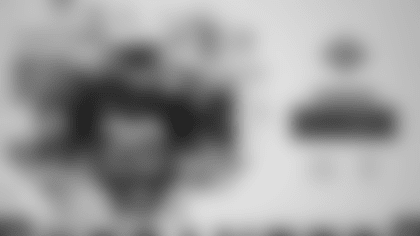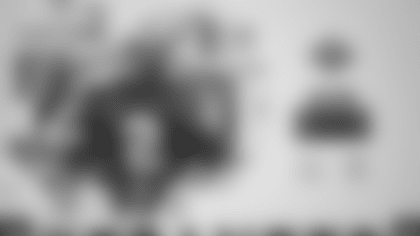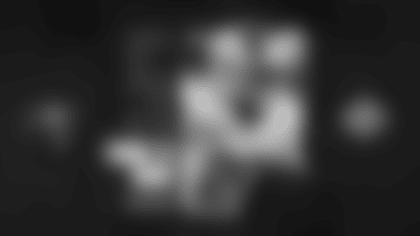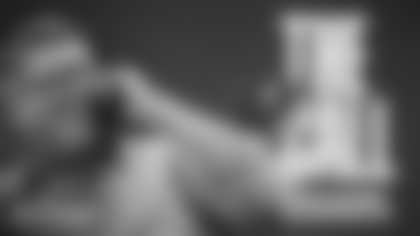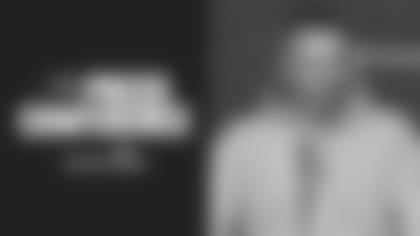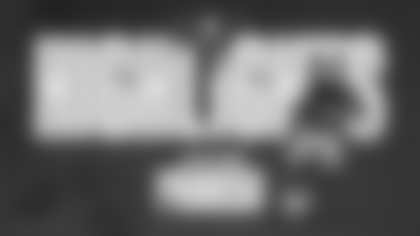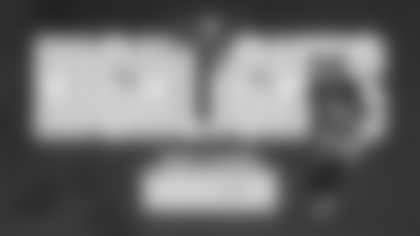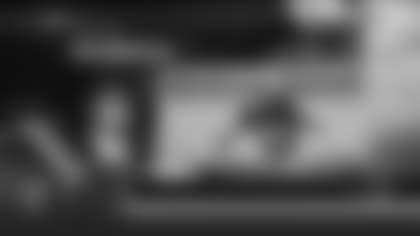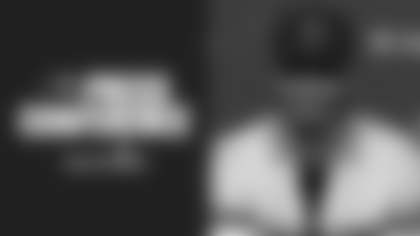Unlike your meetings that could have probably been emails, the NFL Annual Meetings in Phoenix, Ariz. have been very productive so far. NFL Communications disseminated the information and the below playing rules were adopted by NFL clubs so far today.
Approved 2019 Playing Rules Summary
1. By Competition Committee; Makes permanent the kickoff rule changes that were implemented during the 2018 season.
[These included no running starts with players on the kicking team lining up on the 34-yard line; a "setup zone" in which eight of the 11 players on the return team are confined to a 15-yard zone near midfield; no need to kneel in the end zone to signal no return; no wedge blocks and no blocking period within the first 15 yards.]
2. By Competition Committee; Expands protection to a defenseless player.
[There will be no blindside blocking where a player initiates a block moving parallel or toward his own endline and makes contact with an opposing player's forearm, shoulder or helmet. It carries a penalty of up 15 yards.]
3. By Competition Committee; Changes the enforcement of double fouls when there is a change of possession.
[If a double foul occurs during a change of possession, such as on a kickoff, the ball will go to the team last gaining possession.]
4. By Competition Committee; Simplifies the application of scrimmage kick rules for missed field goals.
[Basically, scrimmage kick rules apply if a member of the opposing team touches the ball before it touches the ground in the end zone or when either team recovers the ball behind the line of scrimmage, like on a block.
There are exceptions – and you can read them if you want in the fine print below.]
5. By Competition Committee; Allows teams to elect to enforce on the succeeding try or on the succeeding free kick an opponent's personal or unsportsmanlike conduct foul committed during a touchdown.
[If a personal foul or unsportsmanlike conduct penalty is committed on a scoring play, the opposing team can elect to enforce it on the ensuing free kick or try.]
UPDATE*
6c. Attached - For one year only, expands the reviewable plays in Instant Replay to include pass interference, called or not called on the field. Also expands automatic replay reviews to include scoring plays and turnovers negated by a foul, and any Try attempt (extra point or two-point conversion).
16. By Competition Committee; to amend Rule 15, Section 1, Article 5 to allow League personnel to disqualify for both flagrant football and non-football acts.
For a full legalese description of these rules, see below:
2019 PLAYING RULE PROPOSAL NO. 1 Amend Rule 6, (Free Kicks, pgs. 23-25) (new language underlined, deleted language struck through):
SECTION 1 PROCEDURES FOR A FREE KICK
ARTICLE 1. FREE KICK.
A free kick is a kickoff or safety kick that puts the ball in play to start a free kick down. It must be made from any point on the kicking (offensive) team's restraining line and between the inbounds lines. (a) A kickoff puts the ball in play at the start of each half, after a try, and after a successful field goal. A dropkick or placekick may be used for a kickoff. Note: During a placekick on a kickoff, the kicking team may use a manufactured tee that is one inch in height and approved by the League. Once the ball has been placed on the kicking tee, the kicking tee cannot be moved. If the ball falls off the tee, or the tee is moved, the covering officials must stop play and restart the timing process without penalty to the kicking team. If the ball falls off the tee a second time during the same free kick down, the kicking team then must either use a player to hold the ball or must kick it off the ground. The ball may be placed on the ground leaning against the tee, provided the tee is in its normal upright position. (b) A safety kick puts the ball in play after a safety. A dropkick, placekick, or punt may be used for a safety kick. A tee cannot be used for a safety kick. Penalty: For illegal kick on a free kick down: Loss of five yards.
ARTICLE 2. RESTRAINING LINES.
The restraining lines for a free kick shall be as follows, unless they are adjusted because of a distance penalty: (a) The restraining line for the kicking team shall be its 35-yard line for a kickoff and its 20-yard line for a safety kick. (b) The restraining line for the receiving team shall be the yard line 10 yards in advance of the kicking team's restraining line.
ARTICLE 3. FREE KICK FORMATION.
When the ball is kicked on a free kick down: (a) Before From the time the kicker approaches begins his approach to the ball and until the ball is kicked,
(1) all kicking team (Team A) players, other than the kicker, must be lined up and remain in their established positions no more than one yard behind their restraining line with at least one foot on the yard line that is one yard behind their restraining line, and both feet must remain on the ground until the ball is kicked; and
(2) at least five players of the kicking team must be on each side of the ball.; and
(3) A at least two players (other than a holder) must be lined up inbounds between the sideline and the bottom (outside) of the yard-line number, and at least two players (other than the holder), must be lined up between the top (inside) of the yard-line number and the inbounds lines and the yard-line number.
Notes:
(1) A holder for a free kick counts as one of the required five players on either side of the ball, regardless of where he is positioned. The holder is never counted as one of the required two players between the inbounds line and the top (inside) of the numbers, regardless of where he is positioned.
(2) A player who lines up one yard behind the restraining line must have at least one foot (either the front or the back foot) touching that yard line. (b) All kicking team players must be inbounds and behind the ball when it is kicked, except: (1) the holder of a placekick (3-18-1-Item 2) may be beyond the line, and (2) the kicker may be beyond the line, provided that his kicking foot is not beyond the line. (c) Until the ball is kicked, all receiving team (Team B) players must be inbounds and behind their restraining line, and at least eight players must be positioned between their restraining line and a spot 15 yards behind their restraining line (the "setup zone"). (See Section 2, Article 1, Item 2-b.)
Penalty: For a player being beyond the restraining line when the ball is kicked (offside), a player being out of bounds when the ball is kicked, a kicking team player other than the kicker being more than one yard behind his restraining line, or either team being in an illegal formation when the ball is kicked: Loss of five yards. (d) Prior to the ball being touched by the receiving team or the end of the kick, it is a foul if a kicking team player voluntarily goes out of bounds (without being contacted by a receiving team player) to avoid a block.
Penalty: For voluntarily going out of bounds without contact: Loss of 5 yards.
ARTICLE 4. CATCH OR RECOVERY OF A FREE KICK.
The following applies to the catch or recovery of a free kick: (a) If a player of the receiving team catches or recovers the ball, he may advance. (b) If the ball is declared dead while in the simultaneous possession of two opposing players, the ball is awarded to the receiving team. (c) A player of the kicking team may legally touch, catch, or recover the ball if: (1) it first touches a receiving team player; or (2) it reaches or crosses the receiving team's restraining line. (d) The ball is dead if: (1) it is caught or recovered by a player of the kicking team. If the catch or recovery is legal, the ball belongs to the kicking team at the dead-ball spot. (2) it is not touched by the receiving team and touches the ground in the end zone (touchback). (e) If the ball comes to rest inbounds anywhere on the field, after reaching the receiving team's restraining line and no player attempts to possess it, the ball becomes dead and belongs to the receiving team at the dead-ball spot. Notes: (1) A player is deemed to have not touched the ball if it is batted or illegally kicked into him by an opponent. Such touching is ignored, though the bat or kick could be a foul for an Illegal Bat or Illegal Kick. (2) For illegal catch or recovery, see 6-2-4.
ARTICLE 5. FREE KICK CROSSES GOAL LINE.
It is a touchback, if a free kick: (a) is not touched by the receiving team, and the ball touches the ground in the end zone before being touched by the receiving team. (b) goes out of bounds behind the receiving team's goal line; (c) strikes the receiving team's goal post, uprights, or cross bar; or (d) is downed in the end zone by the receiving team.
ARTICLE 6. END OF FREE KICK.
A free kick ends when either team possesses the ball, or when the ball is dead, if that precedes possession. A running play begins when the receiving team establishes possession of the ball.
ARTICLE 7. SHORT FREE KICK.
If the ball has not been touched by either team after the kick and rolls dead in the field of play before reaching the receiving team's restraining line, the ball belongs to the receiving team at the dead-ball spot.
SECTION 2 OTHER FREE KICK FOULS ARTICLE
1. BLOCKING.
Item 1. Kicking Team. (a) Between the Restraining Lines(10 yards). Prior to Until the ball being illegally touched, a kicking team player may not block or use his hands or arms against an opponent between the restraining lines, except to push or pull aside a receiver who is actively attempting to obstruct his attempt to proceed downfield. After the ball is legally touched, a kicking team player may legally block an opponent, and he may use his hands and arms to push or pull an opponent out of the way in a personal attempt to recover the ball. (b) At or Beyond Five Yards Beyond Receiver's Restraining Line (Team B) (Next Five Yards). Until the ball is legally touched or touches the ground, a kicking team player may not block or use his hands or arms against an opponent in the area that is at or in the area no more than five yards beyond the receiving team's (Team B) restraining line, except to push or pull aside a receiver who is actively attempting to obstruct his attempt to proceed downfield. After the ball is legally touched or touches the ground, a kicking team player may legally block an opponent anywhere, and he may use his hand and arms to push or pull an opponent out of the way in a personal attempt to recover the ball. During the kick, the kicking team is subject to the blocking restrictions of the defense. For the exception prohibiting a block in the back by the kicking team while the ball is in flight, see 12-13-b-Note. Item 2. Receiving Team. (a) After the ball is kicked, receiving team players are subject to the blocking restrictions of the offense (see 12-1-1–3), and they may use their hands/arms legally to push or pull an opponent out of the way in a personal attempt to recover the ball. (ba) First Fifteen Yards. Until the ball is legally touched or the ball hits the ground, no player on the receiving team may initiate a block against the kicking team in the 15-yard area between the kicking team's (Team A) restraining line and five yards behind the receiving team's (Team B) restraining line. (cb) More than Fifteen Yards Beyond Kicker's Restraining Line. After the ball is kicked, a double-team block is permissible only by players who were initially lined up in the setup zone. A double-team block is defined as two players from the setup zone coming together in an attempt to block for the runner. The receiving team may legally block more than fifteen yards beyond the kicking team's restraining line. (c) After the ball is kicked, receiving team players are subject to the blocking restrictions of the offense (see 12-1-1–3), and they may use their hands/arms legally to push or pull an opponent out of the way in a personal attempt to recover the ball. Note: A "wedge block" is not permitted at any time. A wedge block is defined as two or more players intentionally aligning shoulder-to-shoulder within two yards of each other, and who move forward together in an attempt to block for the runner. Penalty: For illegal blocking or use of hands by either team: Loss of 10 yards. (d) After the ball is kicked, no player who was initially lined up outside the setup zone is permitted to come together with any other player (double-team) in an attempt to block for the runner A "double-team block" is permissible only by players who were initially lined up in the setup zone at the time of the kick. Any other players may not participate in a double-team block at any time during a kick or during the return A double-team block is defined as two or more players who contact an opponent at the same time (e) A "wedge block" is not permitted by any players at any time. A wedge block is defined as two or more players intentionally aligning shoulder-to-shoulder within two yards of each other, and who move forward together. The foul for a wedge block occurs at that point; actual contact with an opponent is not necessary. For an illegal wedge or an illegal double-team block during the kick or during the return: Loss of 15 yards. If the foul occurs during the kick, enforcement is from the spot of the foul. If the foul occurs in Team B's during the return, the penalty is enforced as customary. If the foul occurs in the receiving team's end zone during the kick, it is enforced from the previous spot. See 12-2-5 for penalty for a low block.
ARTICLE 2. RUNNING INTO FREE KICKER.
A player of the receiving team is not permitted to run into the kicker before he recovers his balance. See also 12-2-6-h for personal fouls against the kicker. Penalty: For running into the kicker: Loss of five yards.
ARTICLE 3. FREE KICK OUT OF BOUNDS.
The kicking team may not kick the ball out of bounds or be the last to touch the ball before it goes out of bounds between the goal lines. If the receiving team is the last to touch the ball before it goes out of bounds, the receiving team puts the ball in play at the inbounds spot. Penalty: For a kickoff out of bounds: The receiving team may elect to take possession of the ball 25 yards from the spot of the kick or at the out-of-bounds spot. Penalty: For a safety kick out of bounds: The receiving team may elect to take possession of the ball 30 yards from the spot of the kick or at the out-of-bounds spot.
ARTICLE 4. FREE KICK ILLEGALLY TOUCHED
Item 1. Ball Reaches Restraining Line. A player of the kicking team may not touch, catch, or recover the ball before it has reached the receiving team's restraining line, unless it has first been touched by a receiving team player. Penalty: For illegal touching of a free kick by the kicking team: Loss of five yards, or the receiving team takes possession of the ball at the spot of the illegal touch.
Item 2. Player Out of Bounds. If a kicking team player goes out of bounds during the kick, he may not touch or recover the ball beyond the receiving team's restraining line, unless it has first been touched by a receiving team player. If a kicking team player touches the ball before reestablishing himself legally inbounds, it is a free kick out of bounds.
Penalty: For illegal touching of a free kick by the kicking team: Loss of five yards.
SECTION 3 ENFORCEMENT OF FOULS ARTICLE 1. ENFORCEMENT FROM PREVIOUS SPOT
If there is a foul during a free kick, enforcement is from the previous spot, and the free kick is made again. However, if the kicking team commits a foul prior to the end of the kick, and the receiving team retains possession throughout the down, it will have the option of enforcing the penalty at the previous spot and replaying the down or adding the penalty yardage to the dead-ball spot.
Exceptions: (a) A personal foul (blocking) after a fair-catch signal is enforced from the spot of the foul; (b) A foul for fair-catch interference is enforced from the spot of the foul; (c) A foul for interference with the opportunity to make a catch is enforced from the spot of the foul; (d) A foul for an invalid fair catch signal is enforced from the spot of the foul; (e) A foul for intentionally forming an illegal double-team, or an illegal wedge whether during the free kick or during the return during the kick and that does not occur in the receiving team's end zone, is enforced from the spot of the foul; (f) For a free kick out of bounds, see Section 2, Article 3; (g) For a free kick illegally touched, see Section 2, Article 4; or (h) Double fouls are enforced according to the customary rules. See 14-5.
Notes: (1) The dead-ball spot for free kicks that result in a touchback is the 25-yard line. (2) In (a), (d), and (e) above, if the foul occurs in Team B's end zone, the enforcement is from the previous spot. Submitted by Competition Committee
Effect: Makes permanent the kickoff rule changes that were implemented during the 2018 season.
Reason: Player Safety.
A 2019 PLAYING RULE PROPOSAL NO. 2 Amend Rule 12, Section 2 to add new Article 7 (Unnecessary Roughness, pg. 49) (new language underlined, deleted language struck through):
ARTICLE 7. BLINDSIDE BLOCK
It is a foul if a player initiates a block in which he is moving toward or parallel to his own end line and makes forcible contact to his opponent with his helmet, forearm, or shoulder. Note: A player may initiate forcible contact inside the tackle box,but is subject to the crackback and "peel back" block restrictions. Penalty: For a Blindside Block: Loss of 15 yards. Submitted by Competition Committee
Effect: Expands protection to a defenseless player.
Reason: Player Safety.
2019 PLAYING RULE PROPOSAL NO. 3 Amend Rule 14, Section 5, Article 2 (Fouls by both teams (Double Fouls), pgs. 60-61) (new language underlined, deleted language struck through):
ARTICLE 2. DOUBLE FOUL WITH A CHANGE OF POSSESSION.
If there is a Double Foul during a down in which there is a change or changes of possession, including if one of the fouls is a post-possession foul by Team B during a scrimmage kick, the team last gaining possession will keep the ball after enforcement for its foul, provided it did not foul prior to last gaining possession ("clean hands"). If the team last in possession does not have "clean hands" when it establishes possession, the penalties offset, and the down is replayed at the previous spot.
Exceptions:
(1) If Team A fouls during a kickoff, punt, safety kick, fair-catch kick, or field-goal attempt prior to the change of possession, Team B may elect to replay the down at the previous spot.
(2) If a safety results from the enforcement of a foul by Team B, the down is replayed at the previous spot.
(3) If both teams foul after the last change of possession (Double Foul After Change of Possession), the penalties are offset, and the team last in possession shall retain the ball, and the fouls offset at the spot where its foul would be enforced if it was the only foul. possession was gained. If the spot where possession was gained is normally a touchback, the ball is placed on the 20-yard line, or the 25-yard line if the impetus was from a free kick. If it is normally a safety, the ball is placed on the one-yard line. On kicking plays, if Team A fouls prior to the change of possession, Team B shall also have the option in (1) above. Submitted by Competition Committee
Effect: Changes the enforcement of double fouls when there is change of possession.
Reason: Competitive equity.
2019 PLAYING RULE PROPOSAL NO. 4 Amend Rule 11, Section 4, Article 2 (Missed Field Goals, pgs. 43-44) (new language underlined, deleted language struck through):
ARTICLE 2. MISSED FIELD GOALS.
If there is a missed field-goal attempt, and the ball has not been touched by the receivers beyond the line of scrimmage in the field of play, or in the end zone before the ball has touched the ground in the end zone, the following shall apply: (a) If the spot of the kick was inside the receivers' 20-yard line, it is the receivers' ball at the 20-yard line; or (b) If the spot of the kick was from the receivers' 20-yard line or beyond the receivers' 20- yard line, it is the receivers' ball at the spot of the kick. Note: These options apply only if the ball has been beyond the line. Exceptions: The special rules pertaining to field goals in (a) and (b) are not applicable, and all general rules for a scrimmage kick will apply when there is a missed field goal and:
(1) If there is a missed field-goal attempt and the ball is touched by the receivers beyond the line of scrimmage in the field of play, or in the end zone before the ball has touched the ground in the end zone, all general rules for a kick from scrimmage will apply, and the special rules pertaining to field goals in (a) and (b) are not applicable; or
(2) the ball becomes dead behind the line of scrimmage and has not been touched by the receivers beyond the line of scrimmage. If a field-goal attempt from anywhere on the field is blocked, and the ball has not been beyond the line of scrimmage, general rules for scrimmage kicks apply, and the special rules pertaining to field goals in (a) and (b) are not applicable.
(3) If the ball has gone beyond the line of scrimmage and returns behind the line untouched by Team B beyond the line, and either team recovers and attempts to advance the ball, all special rules for missed field goals in (a) and (b) are no longer applicable, and general rules for scrimmage kicks apply. If either team recovers and does not attempt to advance the ball, Team B has the option to take the ball at the dead-ball spot or the spot of the kick. Note: If a foul occurs during an unsuccessful field-goal attempt in (1), or (2), or (3) above, Rule 9-5-1 governs.
(4) If the receiving team commits a post-possession foul during the kick, all special rules for missed field goals in (a) and (b) are no longer applicable, and general rules for scrimmage kicks apply.
Note: If the ball has not been touched by the receivers beyond the line in the field of play and goes out of bounds in the field of play after being touched by a receiver in the end zone, it is the receiving team's option to take the ball at the spot of the kick or the receiving team's 20-yard line.
SUPPLEMENTAL NOTES:
(1) If the receivers do not touch the ball beyond the line of scrimmage in the field of play or in the end zone, and the ball bounces back into the field of play after it touches the ground on or behind the receiver's goal line, it is the receiver's ball at the spot of the kick. If the attempt was from inside the 20-yard line, it is a touchback. The ball is dead as soon as it touches the ground in the end zone. the ball is dead as soon as it touches the ground in the end zone, and it is the receivers' ball at the spot of the kick, or at the 20-yard line if the attempt was from inside the 20-yard line.
(2) If the ball goes out of bounds after it is first touched by the receivers beyond the line of scrimmage in the field of play, it is the receivers' ball at the out-of-bounds spot.
(3) If the receivers first touch the ball beyond the line of scrimmage in the field of play or in the end zone, and the kickers recover, the ball belongs to the kickers at the spot of recovery. If the recovery is in the end zone, it is a touchdown.
(4) If the receivers first touch the ball beyond the line of scrimmage in the field of play, and without any new impetus the ball rolls into the end zone where it is declared dead in the possession of the receivers, it is a touchback.
(5) For a successful field goal, or for an unsuccessful attempt that does not land in the field of play, the maximum amount of time that can run off the game clock is five seconds. Submitted by Competition Committee
Effect: Scrimmage kick rules apply if a Team B player touches a missed field goal attempt in the end zone before the ball touches the ground, or when either team recovers the ball behind the line of scrimmage.
Reason: Simplifies rule.
2019 PLAYING RULE PROPOSAL NO. 5 Amend Rule 14, Section 2, Article 3 (Fouls During a Score, pg. 57) (new language underlined, deleted language struck through):
Article 3. Foul During a Score. If a team commits a personal or unsportsmanlike conduct foul, or a palpably unfair act, during a down in which the opponent scores, the penalty is enforced on the succeeding free kick (unless the score resulted from the enforcement). On a touchdown, the penalty, whether a live ball or dead ball foul or a foul between downs, can be enforced on the succeeding kickoff or Try. On a successful Try kick, any foul by Team B that does not result in a retry or negate a score may be enforced on the succeeding free kick. Exception: If a personal foul, unsportsmanlike conduct foul, or a palpably unfair act occurs on a touchdown or successful field goal, the scoring team has the option to begin a new series or to replay the down following enforcement of the penalty from the previous spot, and the score does not count. On a successful Try kick, the scoring team has the option to replay the down following enforcement of the penalty from the previous spot or the other Try spot. Submitted by Competition Committee
Effect: Teams can elect to enforce on the succeeding try or on the succeeding free kick an opponent's personal or unsportsmanlike conduct foul committed during a touchdown.
Reason: Increase options for penalty enforcement.
2019 PLAYING RULE PROPOSAL NO. 6C
For one year only, amend Rule 15, Section 2, Articles 2, 4, and 5 (Instant Replay, pgs. 62-63) (new language underlined, deleted language struck through):
SECTION 2 INSTANT REPLAY
The League will employ a system of Instant Replay Review to aid officiating as defined below. The following procedures will be used:
ARTICLE 1. COACHES' CHALLENGE. In each game, a team will be permitted two challenges that will initiate Instant Replay reviews. The Head Coach will initiate a challenge by throwing a red flag onto the field of play before the next legal snap or kick. Each challenge will require the use of a team timeout. If a challenge is upheld, the timeout will be restored. A challenge will only be restored if a team is successful on both of its challenges, in which case it shall be awarded a third challenge, but a fourth challenge will not be permitted under any circumstances.
A team may challenge any reviewable play identified in Article 5 below, except when the on-field ruling is:
(a) a score for either team;
(b) an interception;
(c) a fumble or backward pass that is recovered by an opponent or goes out of bounds through an opponent's end zone; or
(d) a muffed scrimmage kick recovered by the kicking team.
A team may not challenge a reviewable play:
(a) after the two-minute warning of each half;
(b) throughout any overtime period;
(c) after committing a foul that delays the next snap; and
(d) after exhausting all of its challenges or timeouts.
If a team initiates a challenge when it is not permitted to do so, it will be charged a timeout.
Penalty: For initiating a challenge when a team has exhausted its timeouts: Loss of 15 yards.
ARTICLE 2. REQUEST FOR REVIEW.A Replay Review will be initiated by a member of the Officiating department from a location in the League office or a Replay Official from a Replay Booth comparable to the location of the coaches' booth or Press Box when the on-field ruling is:
(a) a score for either team;
(b) an interception;
(c) a fumble or backward pass that is recovered by an opponent or goes out of bounds through an opponent's end zone;
(d) a muffed scrimmage kick recovered by the kicking team;
(e) after the two-minute warning of each half;
(f) throughout any overtime period; and
(g) any disqualification of a player.; and
(h) any Try attempt (successful or unsuccessful).
There is no limit to the number of Replay Reviews that may be initiated by personnel designated in this Article. The ability of the designated personnel to initiate a review will be unrelated to the number of timeouts that either team has remaining, and no timeout will be charged for any review initiated pursuant to this Article. The designated personnel must initiate a review before the ball is next legally put in play. Such reviews will be initiated regardless of whether a foul is committed on the play that, if accepted, would negate the on-field rulings listed in (a)-(d) above.
ARTICLE 3. REPLAY REVIEWS. All Replay Reviews will be conducted by a designated member of the Officiating department at the League office. During the review of on-field rulings other than player disqualifications, the designee shall consult with the Referee, who will have access to a hand-held, field-level device. A decision will be reversed only when there is clear and obvious visual evidence available that warrants the change.
Prior to consulting with the Officiating department designee, the Referee will discuss the play with the covering official(s) to gather any information that may be pertinent to the review.
Each review will be a maximum of 60 seconds in length, timed from when the hand-held, field-level device is provided to the Referee.
Unless the Replay Review is for a player disqualification, all reviewable aspects of the play may be examined and are subject to reversal, even if not identified in a coach's challenge or if not the specific reason for a review initiated by a member of the Officiating department or the Replay Official.
ARTICLE 4. NON-REVIEWABLE PLAYS.The following play situations are not reviewable:
(a) Fouls, except for Article 5(g) and (j) below.
(b) Spot of the ball and runner:
(1) Runner ruled down by defensive contact or out of bounds (not involving fumbles or the line to gain).
(2) The position of the ball not relating to first down or goal line.
(3) Whether a runner's forward progress was stopped before he went out of bounds or lost possession of the ball.
(4) Whether a runner gave himself up.
(c) Miscellaneous:
(1) Field Goal or Try attempts that cross above either upright without touching anything.
(2) Erroneous whistle.
(3) Spot where an airborne ball crossed the sideline.
(4) Whether a player was blocked into a loose ball.
(5) Advance by a player after a valid or invalid fair catch signal.
(6) Whether a player created the impetus that put the ball into an end zone.
ARTICLE 5. REVIEWABLE PLAYS.The Replay System will cover the following play situations:
(a) Plays involving possession.
(b) Plays involving touching of either the ball or the ground.
(c) Plays governed by the goal line.
(d) Plays governed by the boundary lines.
(e) Plays governed by the line of scrimmage.
(f) Plays governed by the line to gain.
(g) Number of players on the field at the snap, even when a foul is not called.
(h) Game administration:
(1) Penalty enforcement.
(2) Proper down.
(3) Spot of a foul.
(4) Status of the game clock.
(i) Disqualification of a player.
(j) Pass interference, called or not called (offensive or defensive) (See Rule 8, Section 5, Articles 1-4).
In situations in which time is deemed to have expired during or after the last play of the first or second half, or of an overtime period in the preseason or regular season, or of an overtime half in the postseason, a timing error is defined as having occurred only when the visual evidence demonstrates that more than one second should be put on the clock.
In the first half, time shall be restored only if the additional play will be a snap from scrimmage. In the second half, time shall be restored only if it is a one-score game (eight points or fewer), and the additional play will be a snap from scrimmage by the team that is behind in the score, or by either team if the score is tied. A correction of a timing error for a team timeout may be made only if there is visual evidence of an official's signal.
If an on-field ruling of a dead ball (down by contact, out of bounds, or incomplete forward pass) is changed, the ball belongs to the recovering player at the spot of the recovery, and any advance is nullified. The recovery must occur in the continuing action following the loss of possession. If the ball goes out of bounds in an end zone, the result of the play will be either a touchback or a safety. If the Referee does not have clear and obvious visual evidence as to which player recovered the loose ball, or that the ball went out of bounds, the ruling on the field will stand.
These reviewable play situations are explained in further detail in the Instant Replay Casebook. Submitted by Competition Committee
Effect: For one year only, expands the reviewable plays in Instant Replay to include pass interference, called or not called on the field. Also expands automatic replay reviews to include scoring plays and turnovers negated by a foul, and any Try attempt (extra point or two-point conversion).
Reason: Integrity of the game.



